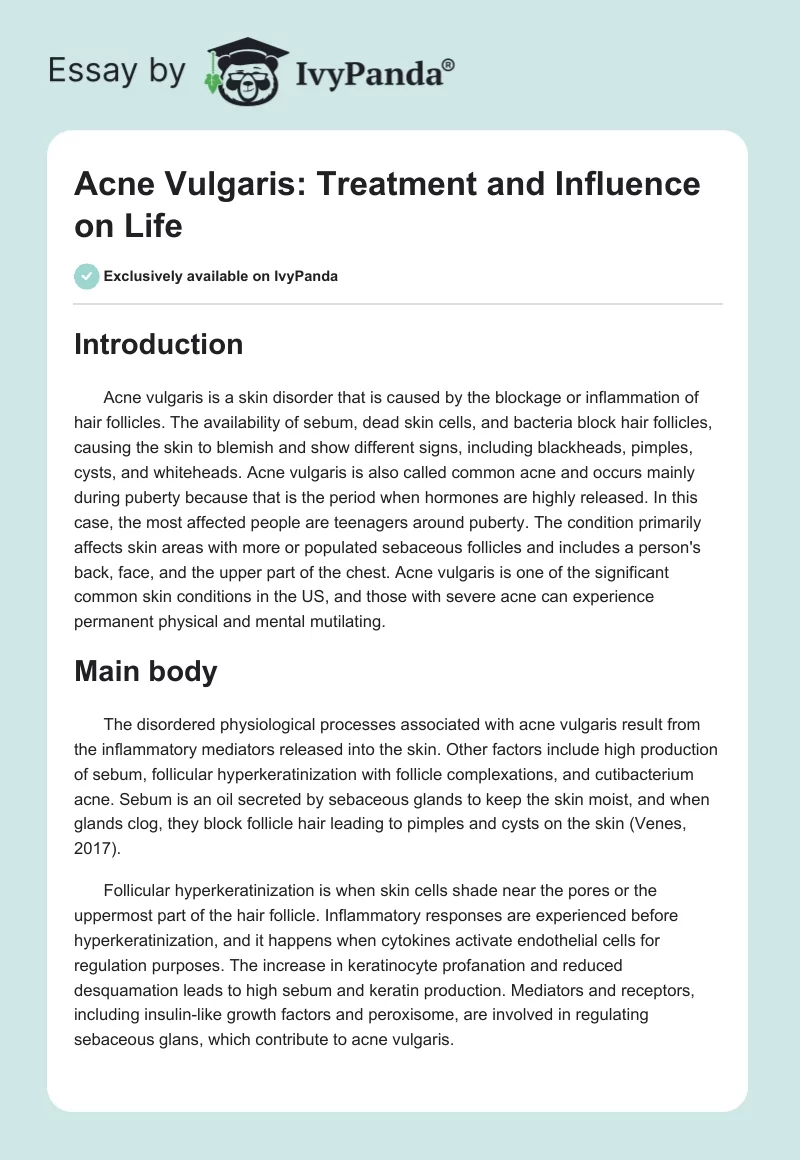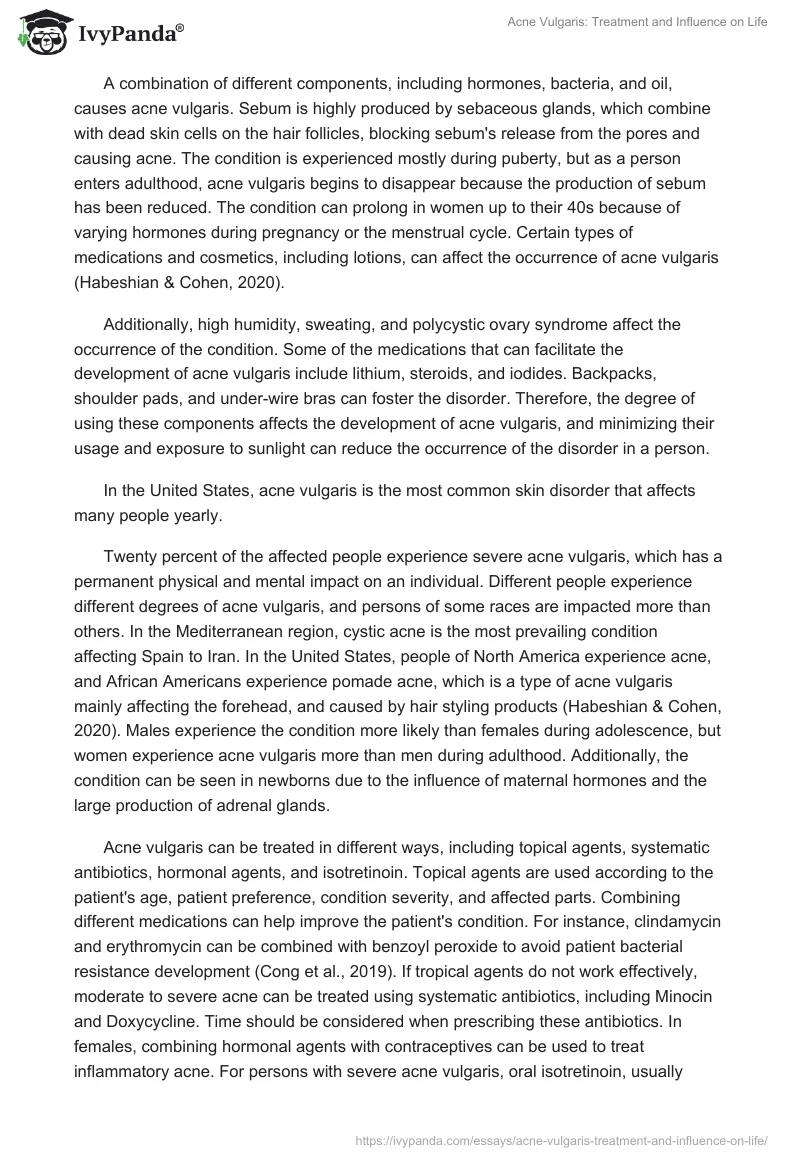Introduction
Acne vulgaris is a skin disorder that is caused by the blockage or inflammation of hair follicles. The availability of sebum, dead skin cells, and bacteria block hair follicles, causing the skin to blemish and show different signs, including blackheads, pimples, cysts, and whiteheads. Acne vulgaris is also called common acne and occurs mainly during puberty because that is the period when hormones are highly released. In this case, the most affected people are teenagers around puberty. The condition primarily affects skin areas with more or populated sebaceous follicles and includes a person’s back, face, and the upper part of the chest. Acne vulgaris is one of the significant common skin conditions in the US, and those with severe acne can experience permanent physical and mental mutilating.
Main body
The disordered physiological processes associated with acne vulgaris result from the inflammatory mediators released into the skin. Other factors include high production of sebum, follicular hyperkeratinization with follicle complexations, and cutibacterium acne. Sebum is an oil secreted by sebaceous glands to keep the skin moist, and when glands clog, they block follicle hair leading to pimples and cysts on the skin (Venes, 2017).
Follicular hyperkeratinization is when skin cells shade near the pores or the uppermost part of the hair follicle. Inflammatory responses are experienced before hyperkeratinization, and it happens when cytokines activate endothelial cells for regulation purposes. The increase in keratinocyte profanation and reduced desquamation leads to high sebum and keratin production. Mediators and receptors, including insulin-like growth factors and peroxisome, are involved in regulating sebaceous glans, which contribute to acne vulgaris.
A combination of different components, including hormones, bacteria, and oil, causes acne vulgaris. Sebum is highly produced by sebaceous glands, which combine with dead skin cells on the hair follicles, blocking sebum’s release from the pores and causing acne. The condition is experienced mostly during puberty, but as a person enters adulthood, acne vulgaris begins to disappear because the production of sebum has been reduced. The condition can prolong in women up to their 40s because of varying hormones during pregnancy or the menstrual cycle. Certain types of medications and cosmetics, including lotions, can affect the occurrence of acne vulgaris (Habeshian & Cohen, 2020).
Additionally, high humidity, sweating, and polycystic ovary syndrome affect the occurrence of the condition. Some of the medications that can facilitate the development of acne vulgaris include lithium, steroids, and iodides. Backpacks, shoulder pads, and under-wire bras can foster the disorder. Therefore, the degree of using these components affects the development of acne vulgaris, and minimizing their usage and exposure to sunlight can reduce the occurrence of the disorder in a person.
In the United States, acne vulgaris is the most common skin disorder that affects many people yearly.
Twenty percent of the affected people experience severe acne vulgaris, which has a permanent physical and mental impact on an individual. Different people experience different degrees of acne vulgaris, and persons of some races are impacted more than others. In the Mediterranean region, cystic acne is the most prevailing condition affecting Spain to Iran. In the United States, people of North America experience acne, and African Americans experience pomade acne, which is a type of acne vulgaris mainly affecting the forehead, and caused by hair styling products (Habeshian & Cohen, 2020). Males experience the condition more likely than females during adolescence, but women experience acne vulgaris more than men during adulthood. Additionally, the condition can be seen in newborns due to the influence of maternal hormones and the large production of adrenal glands.
Acne vulgaris can be treated in different ways, including topical agents, systematic antibiotics, hormonal agents, and isotretinoin. Topical agents are used according to the patient’s age, patient preference, condition severity, and affected parts. Combining different medications can help improve the patient’s condition. For instance, clindamycin and erythromycin can be combined with benzoyl peroxide to avoid patient bacterial resistance development (Cong et al., 2019). If tropical agents do not work effectively, moderate to severe acne can be treated using systematic antibiotics, including Minocin and Doxycycline. Time should be considered when prescribing these antibiotics. In females, combining hormonal agents with contraceptives can be used to treat inflammatory acne. For persons with severe acne vulgaris, oral isotretinoin, usually taken with meals, effectively treats severe acne, whereas other methods have shown no response.
Conclusion
In conclusion, acne vulgaris is a skin disorder that affects most Americans, and during adolescence, males experience it more than females. In women, the condition can be experienced up to the age of 40s. Acne vulgaris varies with place, sex, and age, with the North Americans experiencing it more than other regions in the US. Some components facilitating acne vulgaris include particular medication and cosmetics, high humidity, polycystic ovary syndrome, and sweating. Different medicines can be applied depending on the condition’s severity, and oral isotretinoin is the most appropriate method of treatment where the drug is taken with meals. Therefore, minimizing the usage of the mentioned products can help reduce acne vulgaris.
References
Cong, T. X., Hao, D., Wen, X., Li, X. H., He, G., & Jiang, X. (2019). From pathogenesis of acne vulgaris to anti-acne agents. Archives of dermatological research, 311(5), 337–349. Web.
Habeshian, K. A., & Cohen, B. A. (2020). Current issues in the treatment of acne vulgaris. Pediatrics, 145, 225–230. Web.
Venes, D. (2017). Taber’s cyclopedic medical dictionary. FA Davis.


